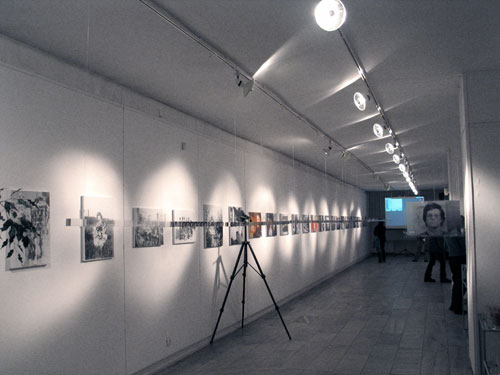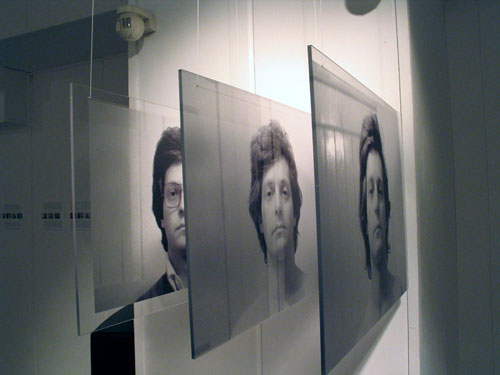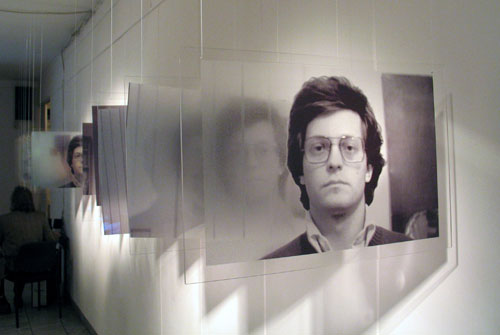



The idea of the PhotoMemory project came to me when I was a student of the Cinematography Department of the National Higher School of Film,
Television and Theatre in Łódź. Originally I wanted to make a film. I wanted to register various accidental statements made by people directly to the camera
- i.e. to the viewer, but due to the technical and economic difficulties typical of the times this idea could not materialize. Later I considered a different
version of this concept; this time I wanted to register a different person each day, using a photographic camera, but that idea also meant numerous
organizational complications. Therefore, gradually, I came to the conclusion that I ought to turn the camera on myself.
I began the realization of this project on July 17th, 1977, which is my birthday. It was probably my fascination with technology and mathematics, the structure
of the project, the occurrence of many sevens in the above date (17.07.1977) and the fact that I turned twenty seven on that day that ultimately made me
set the as yet untitled project in motion. For the next three years using an Exakta camera I took a self-portrait of mine every day. Those photographs were
later successively exhibited as large-scale photographs/calendars that followed the weekly pattern of days in a month.
Many years later I decided to return to this project. Subconsciously I was looking for some pretext, event or a date to begin anew. At last rejecting various
cataclysms, catastrophes and other dramatic events of interest to the media, I decided that it would be best to begin with a date again - with numbers. Thus
I decided to start the second (2nd) part of the project on February 2nd, 2002 (which can be also noted as 02.02.02).
Nowadays my project is carried out using a digital camera - and appropriately to the obviously dominating tendency in today's media, as well as to my
own interests, I also present my work in the Internet. Only in 2002, twenty five years later, could I return to the original source of my idea. A digital camera enables me to register almost every encounter or short statement, both in the form of a film and by means of a completely new tool, which is the so-called
"voice" function that registers a photograph along with the sound accompanying the image.
All in all, one of the sources of this idea is the shyness that I display in personal contact with other people, and that - plus the aforementioned technical
and economic circumstances - is what finally made me turn the camera on myself. Thanks to my collaboration with Michał Silski who combines the talents
of an artist, technician and programmer, the project also exists in multimedia form and in the Internet. To celebrate the 30th anniversary of the birth of PhotoMemory we shall initiate a new function of the programme which - both locally and in the Internet - will enable the viewers to create their own private
PhotoMemories, and thus, thanks to the web, the contents of all other PhotoMemories can now be combined and united.
Perhaps, as far as I am concerned, it is one of the ways that can help me solve the problems I have in communicating with the world.
PhotoMemory 1977-2007 materializes on the eve of the 30th anniversary of the initiation of the PhotoMemory project. I decided to include the
documentation of two different paths in this exhibition: my own (documented by my self-portraits), and the path that photography has travelled during that
time - from its classical to digital and virtual forms.
It is a kind of a journal in which I photographically "jot down" everything that concerns me. In time I started adding other materials beside self-portraits to
my memoirs - short flicks of everyday life, fragments of meetings with people and various events. Fragments - because they only last as long as evolving
technology allows them: at first my works are merely photographs, later they become a few seconds long takes, and finally they turn into audio-video files
which gradually become longer and longer. Briefly speaking, PhotoMemory shows what has happened to me and to the photographic medium during those
few decades. Accordingly, starting in 1977 and moving to the present day,
I shall present a cross-section of my project at this exhibition, along with its latest
Internet version and subsequent versions of PhotoMemory in the form of multiphotography and an interactive film.
Józef Żuk Piwkowski, 2007
How can we represent time?
The problem seems as old as art itself. Desperate attempts to render something that by definition cannot be rendered, especially in a discipline that
uses such static forms as plastic arts, have tormented whole generations of artists. From simultaneous scenes in mediaeval paintings in which time was
suspended like a biological specimen in formalin, to Giacomo Balli's impressions resembling a series of quasi-filmic frames and the works of cubists
undermining the temporal and spatial staticness of representation, we are stunned by persistent attempts undertaken to overcome the two or three
dimensions at plastic arts' diposal. Nevertheless, they could not escape illusion, as neither cubists nor futurists succeeded in distilling the essence of time
- they rather cut out slices from the cake of fictional space/time continuum. The rule of pars pro toto, however, seems to be an indispensable sacrifice
made on the altar of grasping the essence of time and imprisoning it in a visual cage. This is because time is a model extremely difficult to photograph, as it
permanently conceals its countenance behind a thick veil of events on which time imprints its stigma. Like detectives arriving at the scene of the crime right
after an extremely clever criminal has fleed, we can only photograph his fingerprints, but not him - never.
Józef Żuk Piwkowski's series PhotoMemory forms a part of this search for the visual equivalent of time. The process of photographying the author's face
in regular time intervals is an attempt at preserving the traces that time leaves on the surface of reality - an attempt not devoid of certain romanticism
but also marked by an avant-garde, or even conceptual methodicalness. Piwkowski started his project as a young artist way back in the 1970s and returned to it a quarter of a century later, continuing the original rhythm of his work, although he has now replaced traditional analogue photography with
digital techniques. His series of self-portraits shows the artist's face in various, usually everyday situations - in the street, in the car, in his ß at or studio.
What strikes us most is the unpretentious and "snapshot" character of most of these pictures, far removed from archetypal beliefs behind the traditionally
accepted form of an artistic self-portrait. In the case in question the author is not presented as an artist and does not insolently emphasize his artistic status
all the time. Moreover, he avoids all visual ornaments that could muddy the clarity of the author's original concept. Confronted with other self-portraits, so
popular in history of art, Piwkowski's works reveal a significant shift in meaning, as the artist does not aspire to play the leading role in this theatre of time.
He merely makes use of his physiognomy as an object of research, like a scientist who calmly but at the same time with hidden excitement observes some
curious plant, methodically registering subsequent phases of its growth and change. Piwkowski's strategy aims at emphasizing precisely this function
of photography as a medium that registers images. His photography rejects aesthetic values, traditionally ascribed to this branch of art almost from
the beginning of its existence, and is rather used as a tool in conceptual projects. Individual, aesthetic value of those photographs is overshadowed by intellectual reflection which the series offers. It resembles, for example, the strategy of artists connected with the Düsseldorf school, especially Berndt and
Hilli Becher - although while their series encouraged reflection on the visual diversity of places and objects contained in a certain semantic set, Piwkowski's
series concentrates on one "object" - the artist's face, broadening instead the spectrum of his interest by the additional dimension of time. Thus it is time
that becomes the main hero of the series.
The interactive Internet PhotoMemory project, accompanying those photographs, proves how strong the artist's tendency to save everyday, sometimes
even trivial events from oblivion is. An enormous calendar, consisting of hundreds of "sub-pages", that begins in the year of Piwkowski's birth and then moves far ahead into the future, includes not only self-portraits but many snapshots and films registering more or less meaningful events in the the
artist's life: a family Christmas supper, vernissages and travels. What especially strikes us in this peculiar visual memoir is the ennoblement of sometimes
apparently unimportant everyday activities and events that resemble landmarks extracted from spaces of the past, vast as an ocean, which give order
to the overwhelming abyss of times of yore. Its value is not always based on the significance of registered events. The most important element seems
to be what we are usually inclined to consider superfluous and omit when looking at photographs and watching video films: the barely visible numbers
in the right-hand bottom corner - dates, hours and minutes - which impassively establish the rhythm of Piwkowski's artistic story. The story that can be
described not as a piece of free artistic creation but rather as an attempt at an almost archival documentation and creation of an internet memory base.
Incidentally, this base keeps growing all the time, which gives Piwkowski's project a deeply processual character - and each of its elements forms but the
next phase of its development. This project, by the way, is also supposed to become a form of reconstructed memory in the future - not only individual, but
collective memory, too, and this goal is to be achieved by means of including in its virtual base photographs, films and memories from sources other than
the artist's archives. Such a reconstruction of the past, based on a simple and at the same time carefully considered idea, resembles the strategy of the avant-garde, deeply pervaded by the aesthetics of the sublime. Such a strategy, reaching the point of contact with the Unspeakable, consequently reaches
an impenetrable wall in its uncompromising attitude and utopian desire to grasp, describe and preserve what can be never entirely grasped, described or
preserved.
Piwkowski's giant visual archive, however, lacks extreme dogmatism and consistency which characterize most avant-garde ventures. Piwkowski's project,
started in 1977 and later set aside for many years up in an artistic attic, is now reborn like a Phoenix from its ashes at the beginning of the new century. This time, too, Piwkowski is not as methodical as one could think judging by such a carefully considered work. Some sub-pages of his calendar devoted
to certain days are completely blank, while other are filled with photographs, films and audio recordings - as if the artist wanted to compensate in this way
for the lacunae in his journal or felt an irrational need to register as much information as possible. Therefore this conceptual project takes on a surprisingly
humanistic hue and begins to resemble a real, intimate, personal journal, filled with memories unevenly and without cold calculation. It is no coincidence
that in the background of his countless self-portraits we can see a mirror - as the photographs from the PhotoMemory series are mirror refl ections of
passing moments, marked by a personal perspective, but devoid of the artist's interference as much as possible. So, in a way, they perform the function
that Stendhal attributed to a novel.
However, the realism that comes into being two hundred years after Stendhal is profoundly democratic and interactive. The web offers practically unlimited
possibilities of sharing our memories of strolling down the road with almost everyone. Every perspective is marked by the stigma of individualism - although
we have to do here with a seemingly impassive registration - which allows us to penetrate in depth a virtually unlimited number of different point of views
on reality, personal ways of perceiving rhythm imposed by time and the flow of memories which is always personal, even if we share it with other people.
The PhotoMemory series is reality passing into oblivion, caught by Piwkowski within this project. The quantity of intimate past registered by the artist is hard
to embrace - in spite of the fact that it is only a small portion of the enormous abyss of memories. Like photographs taken by the Hubble telescope which
show only a tiny fragment of outer space, Piwkowski's project makes us realize one thing: the overwhelming magnitude of what we will never be able to
register.
Gabriela Jarzębowska, 2007
translated by: Maciej Świerkocki

Look also:
PhotoMemory project
2b Gallery
Major projects

Exhibition organized as part of an
OPERATIONAL PROGRAMME
"Art Promotion"